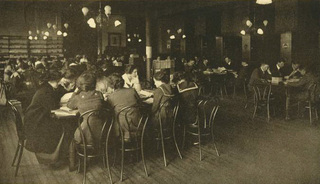 | Back to e-WV
| Back to e-WV
 The West Virginia Encyclopedia
The West Virginia Encyclopedia
 | Back to e-WV
| Back to e-WV
 The West Virginia Encyclopedia
The West Virginia Encyclopedia

Several West Virginia colleges originated as normal schools, whose purpose was to train primary and secondary school teachers. The need for normal schools was recognized early in our history as a state. On February 3, 1865, the legislature asked the governor to appoint a commission to plan a state normal school system. On February 27, 1867, the legislature established the West Virginia State Normal School at Marshall to provide ‘‘instruction and practice for common school teachers in the science of education and the art of teaching.’’ Soon five other normals were established, in Fairmont (1869), in West Liberty (1870), and in Glenville, Athens, and Shepherdstown (all 1872). Over time, the normal schools matured into Marshall University, Fairmont State University, West Liberty State College, Glenville State College, Concord University, and Shepherd University. A board of regents governed the system.
All the normals but Fairmont were essentially high schools in the early years. Their fate was entangled in state politics for decades, with meager appropriations and periodic attempts in the legislature to abolish the schools. In 1877, the normals established a three-year term beyond the elementary grades, with occasional curriculum revisions thereafter. There were 360 normal students statewide in 1879–80, and after 1900 women outnumbered men as students at most of the schools. There were 2,592 normal school students in 1908.
The first normal schools were for whites only. Then, on February 21, 1895, the legislature established Bluefield Colored Institute (now Bluefield State University) to provide a normal school course for blacks.
With the development of more high schools, the normal schools upgraded their offerings. They increasingly focused on teacher training courses, which were implemented in all the normals in 1905–07. By 1917, the regents began to abolish high school courses in the normal schools, and, in 1920, the state board of education authorized Marshall College to offer a bachelor’s degree in education in addition to its normal diploma. The other normals soon followed. In 1931, the legislature renamed the remaining normal schools as state teachers colleges.
Written by Barbara J. Howe
Ambler, Charles H. A History of Education in West Virginia: From Early Colonial Times to 1949. Huntington: Standard Printing & Publishing, 1951.
Rice, Otis K. "West Virginia Educational Historiography: Status and Needs," in Ronald L. Lewis & John C. Hennen Jr., eds, West Virginia History: Critical Essays on the Literature. Dubuque, IA: Kendall-Hunt Pub., 1993.